2020
April
25
|
Life in wartime, continued
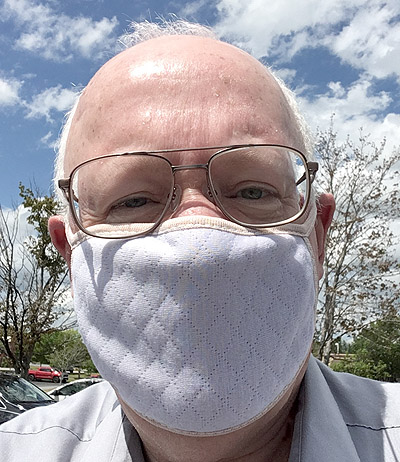
Pro-tip: If your daughter gives you a feminine-looking pink mask, you can wear it
inside out as a white mask.
We've had new directions from the governor
(archived copy here), and, basically, he's
changing the restrictions so they are based on sanitation rather than type of business.
I think that is a good thing. There's no reason a barber shop can't be as
sanitary as a grocery store if it wants to. At the grocery store, you're exposed
to a vastly larger number of people's germs.
Contrary to press coverage, Georgia is not "opening everything back up." Georgia is
changing over to a more sustainable set of restrictions.
In the long run, sanitation is going to be what saves us. The WHO reports that infection
by COVID does not leave people immune. That means "herd immunity" isn't going to work
(and, anyhow, millions would have to die before that was achieved).
Herd immunity through vaccination is what we hope for; but in the meantime, the
winning tactic is to cut down the spread rate so that the virus becomes rare.
The spread rate, R, is the average number of new cases that arise from each case.
For COVID it is believed to be about 2.5.
That's why it spreads so fast and why we have lockdowns.
Suppose R were 0.5; that is, only half of infected cases led to new cases.
Then the virus would die out. In fact, anything below 1.0 will make the virus die out,
although obviously, the lower we get it, the faster we win.
And I don't think it's too hard to get R down from 2.5 to less than 1.
That is not a huge decrease. It's not hard to reduce your exposure to 1/10 or even 1/100
of what it would have been without precautions. Wash your hands more, avoid crowds,
and get other people to do the same.
I think we are headed for a permanent change in many of our national habits.
Crowded bars, restaurants, and parties are things we are going to have to view as risky
for a long time to come. Young people's social life will be particularly affected.
At the other end of the age range, nursing homes need to be smaller, or divided into
sections. Enormous high schools aren't such a good idea; nor are enormous churches.
In fact, churches are going to need to rethink the role of gregariousness, large crowds,
and "small groups" — I'll write more about that later.
[Update:] In the original version of this article I followed numerous other articles
that said R0 or R0 instead of R.
More properly, R0
is the initial value of R at the beginning of an epidemic, before
anything has happened to modify it.
Permanent link to this entry
Why modeling the epidemic is so hard
Many of us have been frustrated, or at least bemused, by the way the
IHME models change so much from week to week.
First we've already peaked, then we're going to peak in two weeks, then we
don't know where we stand, then it flips back again...
I want to share with you some mathematics to demonstrate why modeling is so hard.
Here's the Georgia raw data for the past few weeks:
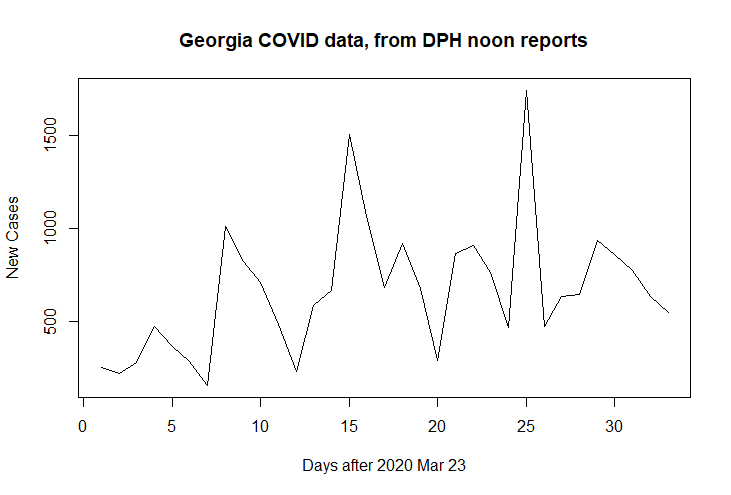
Now, clearly, we are looking at noisy data.
Even if the case rate were basically constant, we wouldn't expect exactly the same
number of cases every day; there's an element of chance involved
(what statisticians call a Poisson distribution).
In addition, cases don't always get reported promptly. Earlier statistics suggest
that there is underreporting
on weekends and a catch-up on Monday or Tuesday.
So... Is the trend up or down? How can we smooth out the irregularities and see?
One simple tactic is to take a moving average, in this case a 3-day moving average
Average each day's number with the two days either side of it. That will smooth out the
weekend lag-and-catch-up, as well as generally making things more even. So here it is:
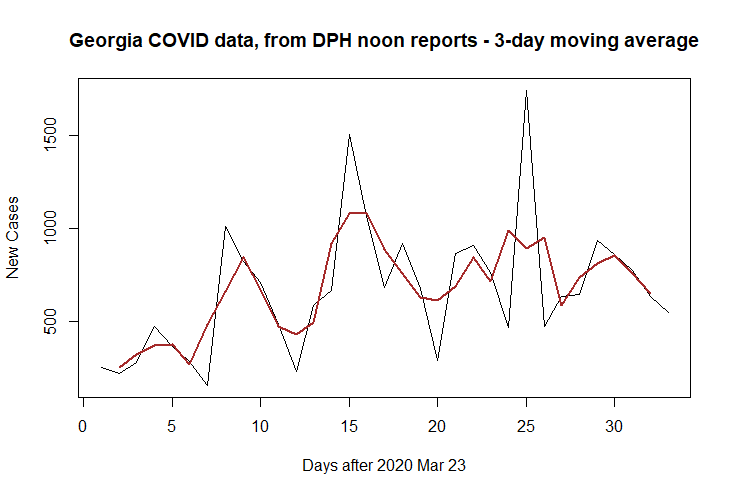
That's a little better. The biggest thing it tells us is that the spike on day 25
is compensated by unusually low values on the days before and after, so it isn't really
a spike. In fact, this is apparently the analysis used by Georgia officials to argue
that we meet the federal guideline of a 2-week downward trend.
We can do better by adding some knowledge. We know what other epidemics are like,
and we know what this epidemic is like in other places.
We expect a definite, smooth hump, not unlike a bell curve.
(If there is going to be a second hump, it definitely hasn't shown up anywhere yet,
so we won't look for signs of it here.)
If we bring in the assumption that there is a hump, can we ask where
the hump is?
Yes. Clay Turner suggested that I fit to the data a quadratic equation (a parabola), which is a
single symmetrical hump. That will tell us where the peak is
and whether the peak is sharp or flat. The peak could perfectly well be off center,
even off the whole graph, or even upside down. What a quadratic cannot do is give us
multiple peaks or even a lopsided peak. So I also fitted a cubic equation, which allows
the peak to be lopsided and even allows two opposite peaks, one right-side-up and the
other upside down.
Here you see the quadratic in red and the cubic in green. They agree very closely.
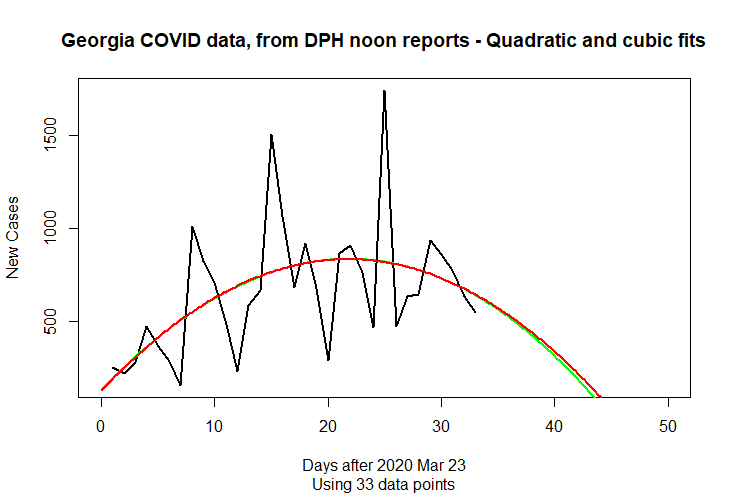
So you might think we have a simple, clear answer: the numbers peaked on day 22
(April 14); as of today we have an 11-day downtrend;
and we'll be down to half of maximum by day 41 (May 3).
But wait a minute. What if we didn't have the last two days' data? They are
particularly low numbers, but they may be low because it's a weekend.
So let's run it again with just the data we had 2 days ago:
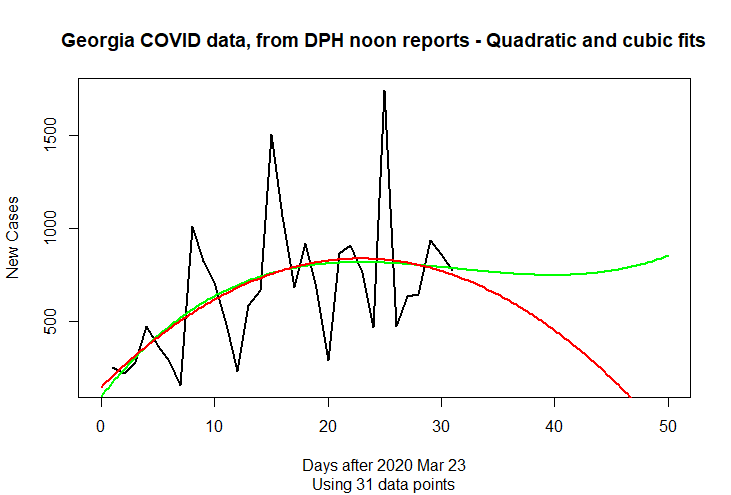
Whoa there! The quadratic is not too different, but the cubic doesn't agree with it;
it seems to think the curve hasn't peaked, merely flattened! The upturn at the far
right means little, but the cubic equation certainly doesn't recognize a definite peak.
Even the quadratic has shifted and now puts the peak on day 25, not 22.
This is why the IHME models are so fickle. Small changes in the data can cause big
changes in the model. Now in this case, there are good reasons to believe the quadratic
is more accurate than the cubic. But the failure of the two to resemble each other
should give us pause. The quadratic assumes a single hump; the cubic doesn't see one.
It is, of course, possible to do much worse. Suppose we were to fit a 10th-degree polynomial
(allowed to have 9 humps). Here's the absurd result:
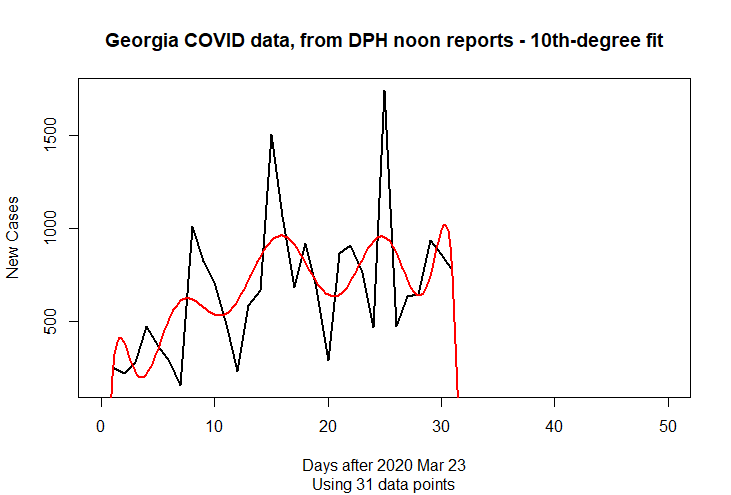
Obviously, the numbers weren't really super-low before the beginning of the series,
nor do we expect them to plummet right after the end.
The goal of the model was just to keep the curve as close to the data as possible,
and it doesn't care what happens outside the range.
You can see all 9 humps, four of them upside down.
That's what high-degree polynomials are like.
If you'd like to experiment with this kind of modeling yourself, the R code and a sample
data set are here.
Permanent link to this entry


|
2020
April
22
|
Misinformation about Georgia
In any war, you can always tell the generals afterward that they did the wrong thing.
So it is with the war on COVID-19. But decisions have to be made using information actually
available, and different kinds of potential harm have to be balanced against each other.
If it had been up to me, I think I would have waited another week to see where we stand
(see below).
But the phased reopening of some Georgia businesses is not as loony as many
journalists are saying, largely because they're getting the facts wrong.
And where journalists stumble, popular chit-chat plunges gleefully into the abyss.
I'm hearing from people who just guessed the contents of
the governor's order from hearing a few words, and then
proceeded to rant about their imaginary version of it.
Surprise: It took President Trump only 24 hours to register his disagreement
with Governor Kemp. Maybe the "reopening" can be scaled back and/or delayed.
Misconception: "Georgia is opening everything back up."
No; a slightly wider range of businesses is allowed to open, subject to
social distancing and sanitation requirements so strict that many of them
probably will choose not to.
Going to grocery stores and the like, I actually see tougher restrictions now than under
earlier local orders, because stores have started limiting the number of people inside.
Questionable: "It's all to get people off the unemployment rolls."
Well, I haven't looked up all the laws, but as far as I know, unemployment applies to
laid-off people whether or not their employer was forced by the government to shut down.
I don't have enough information to comment further.
I don't know whether Georgia has different rules when the employer is forced to close
than when it closes voluntarily.
Looking further into this, it's complicated. The main problem is that we are going to
have "zombie businesses" that are not legally forbidden to operate, but in fact, for
practical reasons, can't actually operate. This does not mix well with unemployment payments
and certain kinds of business insurance. I'm not researching it further because I'm
expecting the situation to change faster than I can track it.
Misrepresentation of fact:"The order did not include banks, software firms, factories, or schools.
It covered businesses usually staffed by poorer people that Kemp wants to keep off the unemployment rolls."
(Quote from Facebook columnist Heather Cox Richardson, who is paraphrasing an AJC
columnist named Chidi.)
Wait a minute... The governor didn't reopen "banks, software firms, factories, or schools"
because he had not closed them! Banks, software firms, and factories stayed open. Schools closed as an
operational decision, not because of the governor's order.
Anyhow, don't "poorer people" often work at factories?
Permanent link to this entry
Has Georgia peaked? You tell me!
The fickle IHME model
has changed again, so now it says we are peaking right now,
rather than a few days ago or a few days in the future. IHME continues to predict no
overcrowding of ICUs in Georgia.
As I understand it, the federally recommended criterion for starting to reopen
businesses is a 14-day downward trajectory (presumably in the new case rate).
So...
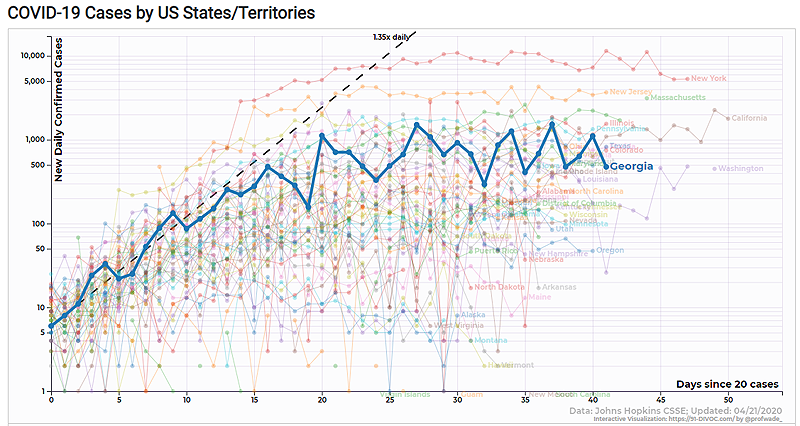
Those are Georgia's new cases per day, from 91-DIVOC,
based on the Johns Hopkins evening reports.
Note the logarithmic vertical scale, which reduces the slope.
As you can see, Georgia's reporting varies a lot from day to day.
To tell what is going on, we need to apply some kind of smoothing, but not too much.
So here's some analysis of my own. These are the number of new cases per day in
Georgia from Georgia DPH noon reports (not the evening reports plotted above).
The raw data are in black, and the red line is a 3-day moving average.
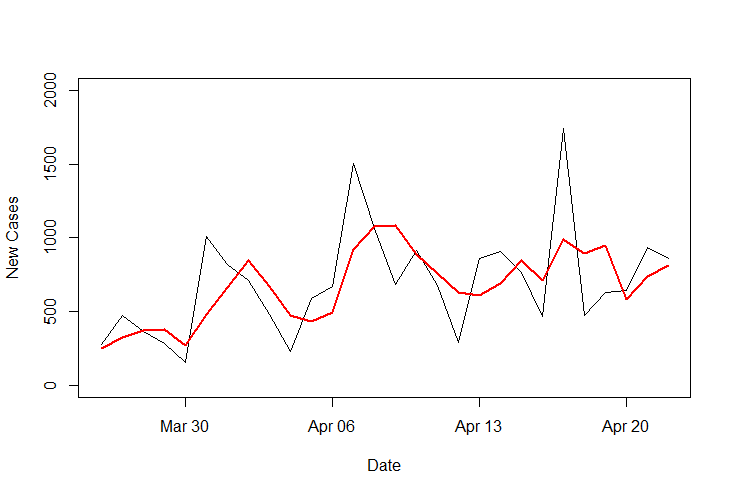
Looking first at the black line, note that we often have an unusually high or low day,
flanked by days that are the opposite (unusually low or high respectively).
That indicates irregular reporting; sometimes one day gets two or three days' cases.
In particular, our all-time high was April 17, but the two days either side of it were
very low. It looks as if three days' cases were all piled together.
That's the rationale for the red line. On each date it plots the average of the three
preceding days.
And with that reasonable smoothing function applied, we do meet the federal criterion,
just barely. We do have a downslope from about April 8 to the present.
I saw a Georgia official quoted pointing this out; they must have done much the same
analysis that I did.
One more note. Increased testing will bias the line to slope upward.
We may see large increases that are just increases in testing, not the disease.
Reportedly, also, Georgia has a backlog of tests a few weeks old that are just now
being processed, coming into the statistics at the same time as newer tests that
are processed more quickly. That also biases the line to slope up.
So... has Georgia peaked? Maybe. If not, it's at least flat.
Update: The next day's reports were not encouraging, but not terrible either.
All I can say is, "I don't know."
Permanent link to this entry


|
2020
April
21
|
Are they letting us out too early?
The governor of Georgia is loosening our lockdown in a slightly odd way.
Before I get to that, let me give a general update.
I stand by everything I said last time (scroll down to see it)
and add that another study, in Los Angeles, also has found a huge number
of people who have COVID-19 antibodies but are unaware of having had the disease.
If that is correct, it completely changes the game; it means that we have only
been tracking severe presentations of COVID-19, not the whole thing.
But I am waiting for experts to comment.
I have almost given up Facebook
because of the amount of arguing there. I can't referee a 50-person quarrel every time I point
out a news item.
Everybody's angry, but they're not sure what to be angry about.
Deep down, I think, they are angry about uncertainty.
Now, to Georgia. The governor had a press conference yesterday and then issued
this document, which is apparently not the whole thing;
statements to the press also mentioned reopening restaurants and theaters with people
seated far apart.
In the document we have so far, here's what I see:
- Medical practices are encouraged to get back to normal (performing non-urgent services),
and that includes dentists, physical therapists, optometrists, and the like.
- Gyms, bowling alleys (a kind of gym, I suppose), and
a lot of licensed personal-care providers
such as hairdressers, massage therapists, and tattoo artists (?)
are allowed to resume work, with additional sanitation precautions.
- The definition of Minimum Basic Operations may have changed; now it seems to
include allowing the aforementioned gyms, hairdressers, etc., to serve customers.
- The definition of Critical Infrastructure is updated to refer
to the latest CISA list, a small change. This is the provision that keeps
banks, factories, farms, and other businesses open.
What's missing? Well, it seems to me that, for example, furniture stores and
clothing stores are safer than tattoo parlors, but they are not being allowed to
reopen. I think some further reshuffling of the provisions is imminent.
Actually, the governor's previous order already expanded
Minimum Basic Operations to allow other businesses to remain open to the public
if sanitation precautions were followed. I missed that.
So apparently you can keep a furniture store open if you want to.
More importantly, there is bitter controversy about whether this should be done.
People's mindset about the virus has changed.
-
People have almost forgotten about flattening the curve.
Our goal was not to exterminate the virus, but rather to keep it down to the level
where hospital ICUs will not be overcrowded.
And Georgia has achieved that, even if we have a second wave equal to the first.
-
Instead, people are now focused on fear of getting the virus and dying.
Of course, we want to prevent as many deaths as possible, but not everyone is at
high risk. And Georgia isn't New York.
-
People are so focused on COVID-19 that they have lost sight of other hazards,
including damage to the economy, which can also cause deaths through poverty.
As I said last time, trading lives for stock market numbers is barbaric,
but saving the maximum number of lives from all hazards is better than just
vanquishing one hazard leaving others in its place.
One of the most interesting statistics I've seen is that the U.S. weekly death rate is
actually lower now than in a normal year. It's normally about 56,000 per week,
but now it's running around 51,000 or lower. I don't have a detailed breakdown, but the
lockdown has apparently reduced car wrecks, other infectious diseases, and even crime.
No avoidable death is acceptable, but this statistic should figure into how you judge
your overall safety at this time.
Update: This statistic apparently did not hold up; subsequent
reports do not confirm it.
[Addendum:]
Another issue is whether to trust the IHME models. The model for Georgia has
recently made sharp changes, first one way and then the other. The trend of the data
did not change. This tells me the models are probably too sensitive to small
fluctuations, especially irregularities in day-to-day reporting.
More here.
Meanwhile, the guilt-trips have started. "Somebody might die because you went to get
supplies to do yard work." A message to that effect is circulating that claims to be
from a hospital administrator in South Georgia. No, no, no... We need to live in a world
of rules, not guilt-trips. People need to be told what is and is not permitted before they do it,
not afterward. We can't play a game of "no matter what you did, it was wrong."
And we can't put everyone out of work, and live on unicorn dust or fairy floss or something,
in a mythical country with no economy.
Finally, we've had a bizarre collapse of the world petroleum market with crude oil
selling for negative prices yesterday. While I'm glad to see foreign cartels totally lose
their power, I fear for the American businesses that are being damaged.
We're still going to need gasoline when the epidemic is over.
Permanent link to this entry


|
2020
April
18
|
Some good news and a lot of bitter controversy
Life in wartime is, for us personally, calm and productive.
We're feeling some relief at having gotten a lot of medical appointments
out of the way, so that now we are a bit less busy.
We aren't having any serious supply problems with food or even toilet paper;
things are scarce in the stores, but we've found enough, and we've gotten
used to doing our shopping a week in advance.
At work, I am as busy as ever, and I'm wary of a new trend toward
having too many online meetings.
I've finally done a bit of astronomy — visual, not photographic —
and have (again) tuned up the declination worm adjustment of my CGEM.
(Hint: It needs to be tight enough to have no slop, but loose enough not to
put an extra load on the motor. I adjusted mine with an ammeter attached.)
Today's project is to undertake the quest of an 8×1.25-mm threading die
and deal with some inadequately cut threads on some aftermarket knob screws.
Hardware stores are open, but if they are crowded, I will have to wait to
get in.
Regarding coronavirus, yesterday there were several pieces of encouraging news.
IHME (at the University of Washington)
suddenly revised its models for Georgia and
many other states.
They had been predicting that Georgia would peak around May 1 with about 50% overcrowding
of intensive care units; now they say Georgia peaked a few days ago and will never have
overcrowded ICUs.
Meanwhile, in both California and Boston there has been some systematic testing of samples
of the population, and the results are that a remarkable number of people have had COVID-19
without symptoms. If this leaves them even temporarily immune (as it should), it is very
good news. There have also been studies of a U.S. Navy aircraft carrier and of the cruise
ship Diamond Princess, both showing that the bulk of cases are asymptomatic.
However, these studies don't overrule everything else we know about this and
other viruses. Experts aren't jumping onto the herd-immunity bandwagon just yet.
The public mood, in the news media, on social media, in the White House, and on the streets,
is one of bitter controversy. Here's a brief summary.
The underlying point of tension is how much more lockdown our economy can sustain
before the cure becomes worse than the disease.
Trading lives for stock market numbers would be barbaric, but trading lives for lives
may be necessary.
Economic collapse causes deaths, especially in third world countries that depends on developed
countries for trade.
Will COVID-19 give us back the world hunger crisis that we had made so much progress on solving?
Closer to home, what we could do for two or even four weeks cannot be done forever.
A second issue is how much good the lockdown has done. Obviously, the lockdown has
put a real dent in the spread of the virus.
But how bad would it have been if we had done less?
Was it growing without bound, or was it close to bumping into some epidemiological
limit, such as an unexpectedly large number of people already resistant to it?
We don't know.
Underlying all of this is the experts aren't sure, and laypeople, taking wild guesses, really
shouldn't be confident that they've guessed correctly.
Now we have needless political division. Overreach by a few local authorities (e.g., breaking
up a drive-in church service) has provoked concern about the constitutional right of assembly,
which has led to protest marches, surprisingly spurred on by our President via Twitter, and now one of them in
Michigan is going to be "armed." That does not sound good.
Even pharmacology has become politicized. About half a dozen drugs may help the virus;
research is ongoing. If you're right-wing, you're supposed to believe in hydroxychloroquine, and
if you're left-wing, you're supposed to be against it. Why should left and right wings have anything
to do with it? Hydroxychloroquine is a tricky, dangerous drug that sends some people right into
cardiac arrest; there are some indication that it may help with COVID-19; there are other
studies showing that it apparently doesn't. Why should political loyalty tell people to believe some
of the studies and ignore the others, rather than putting them all together to try to figure out what
is going on?
Another issue is distrust of experts. Some people now think all these mathematical models
are just lies spread by some oppressive authority. I reply that (1) the models I've been looking at
come from independent institutions, not the government; (2) I've been doing some modeling myself and
saw the IHME revision coming (and posted about it on Facebook). It's mathematics.
And that raises another issue, propaganda. Yesterday I speculated that hostile foreign powers
might be using COVID-related misinformation to keep Americans upset, angry, and scared.
After all, we had a flurry of Russian propaganda on Facebook before the election, and I'm starting
to see things that resemble it again. Several knowledgeable people replied that yes, indeed, this
is happening, and it comes not only from foreign powers but also from extremist groups operating in
our country (with or without foreign backing).
Fellow citizens, please do your best to keep in touch with reality — with facts.
|

















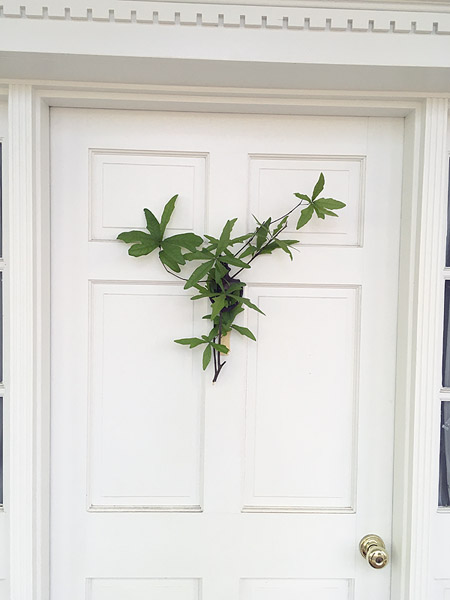


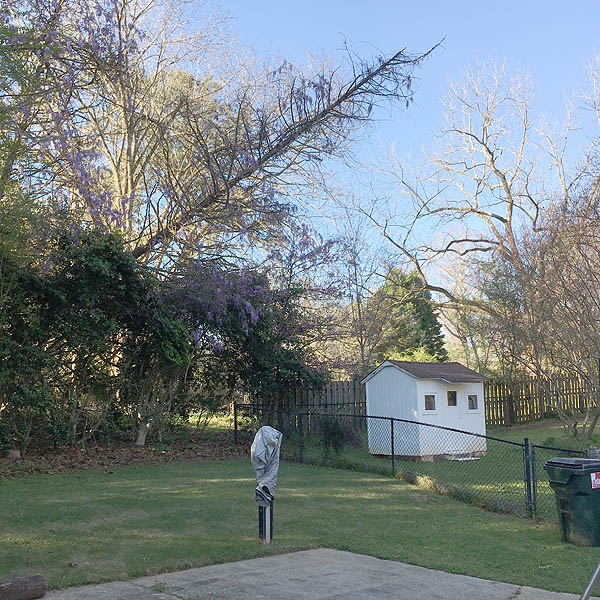
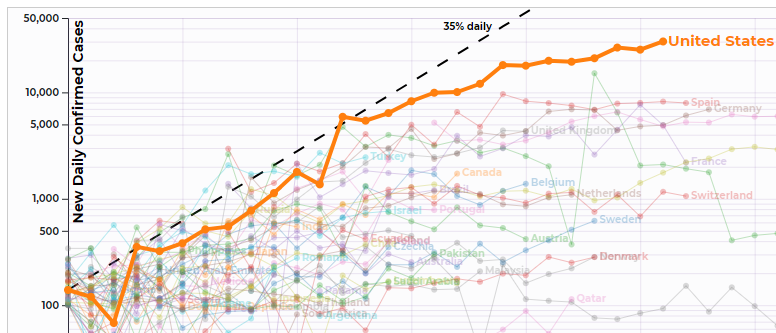
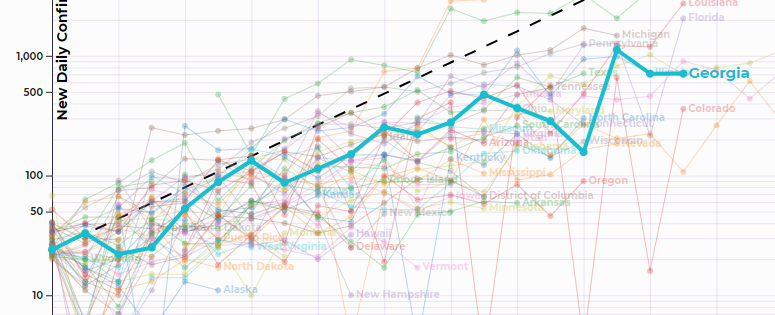
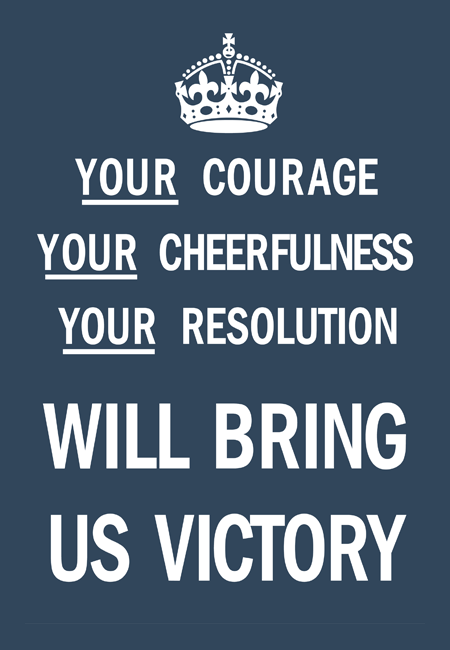
 There's a shortage of webcams for videoconferencing right now.
I briefly thought about using my ASI120MM-S astrocamera
(monochrome, in infrared) with its fisheye lens but concluded
I would look too strange, so I snapped up a Microsoft LifeCam VX-5000
on eBay.
There's a shortage of webcams for videoconferencing right now.
I briefly thought about using my ASI120MM-S astrocamera
(monochrome, in infrared) with its fisheye lens but concluded
I would look too strange, so I snapped up a Microsoft LifeCam VX-5000
on eBay.